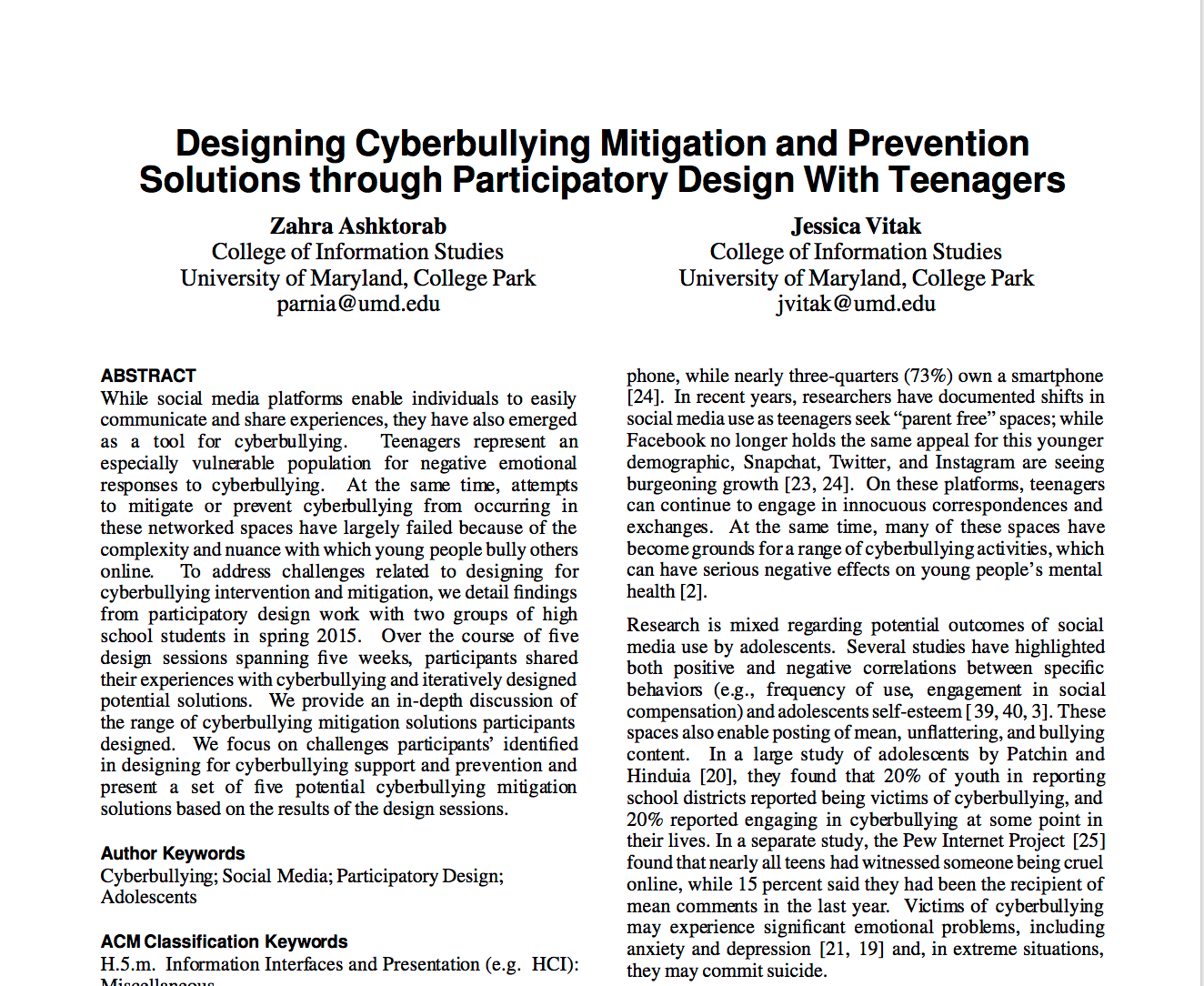
While social media platforms enable individuals to easilycommunicate and share experiences, they have also emergedas a tool for cyberbullying. Teenagers represent anespecially vulnerable population for negative emotionalresponses to cyberbullying. At the same time, attemptsto mitigate or prevent cyberbullying from occurring inthese networked spaces have largely failed because of thecomplexity and nuance with which young people bully othersonline. To address challenges related to designing forcyberbullying intervention and mitigation, we detail findingsfrom participatory design work with two groups of highschool students in spring 2015. Over the course of fivedesign sessions spanning five weeks, participants sharedtheir experiences with cyberbullying and iteratively designedpotential solutions. We provide an in-depth discussion of the range of cyberbullying mitigation solutions participantsdesigned. We focus on challenges participants’ identifiedin designing for cyberbullying support and prevention andpresent a set of five potential cyberbullying mitigationsolutions based on the results of the design sessions.
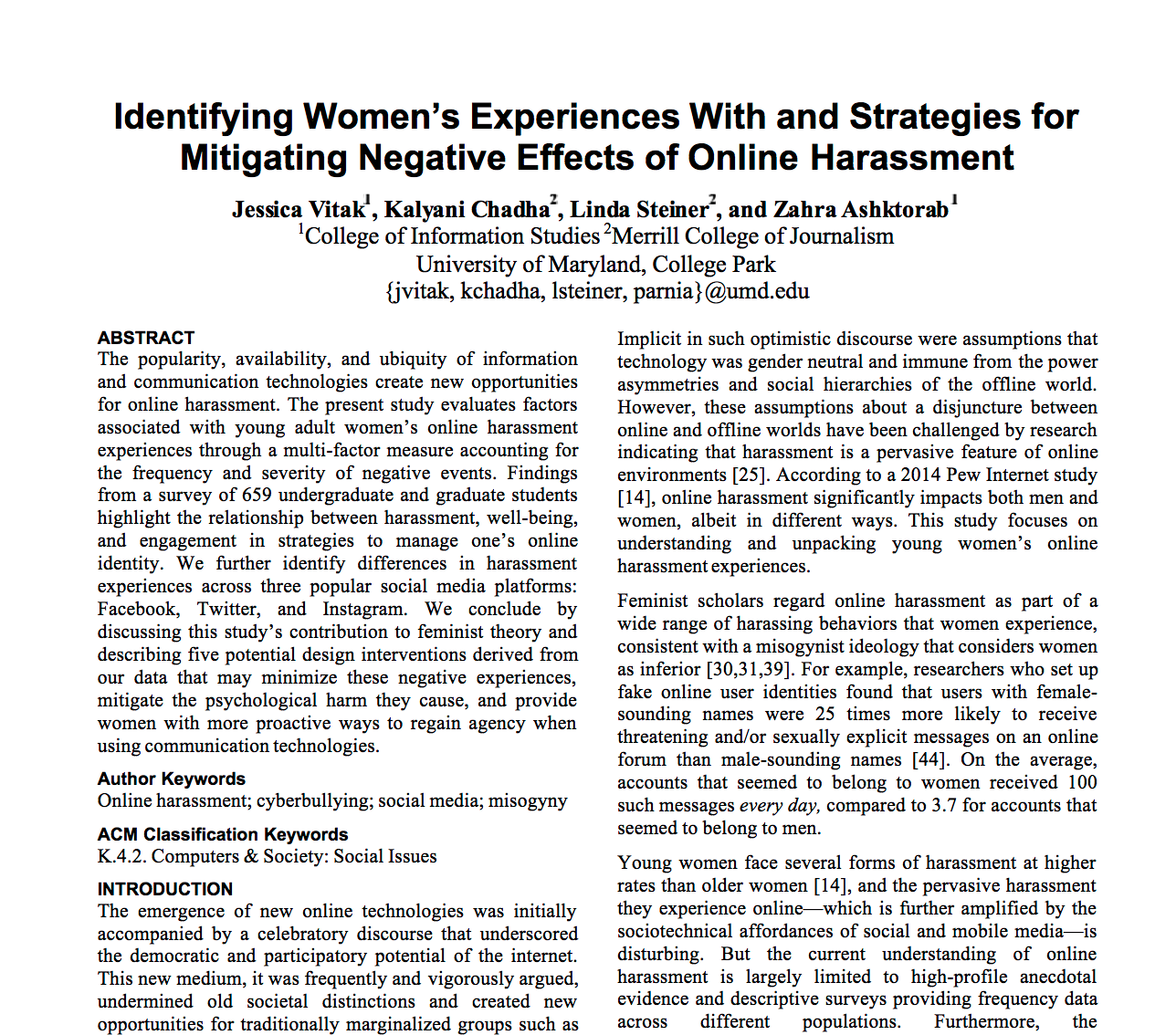
The popularity, availability, and ubiquity of information and communication technologies create new opportunities for online harassment. The present study evaluates factors associated with young adult womenÕs online harassment experiences through a multi-factor measure accounting for the frequency and severity of negative events. Findings from a survey of 659 undergraduate and graduate students highlight the relationship between harassment, well-being, and engagement in strategies to manage oneÕs online identity. We further identify differences in harassment experiences across three popular social media platforms: Facebook, Twitter, and Instagram. We conclude by discussing this studyÕs contribution to feminist theory and describing five potential design interventions derived from our data that may minimize these negative experiences, mitigate the psychological harm they cause, and provide women with more proactive ways to regain agency when using communication technologies.
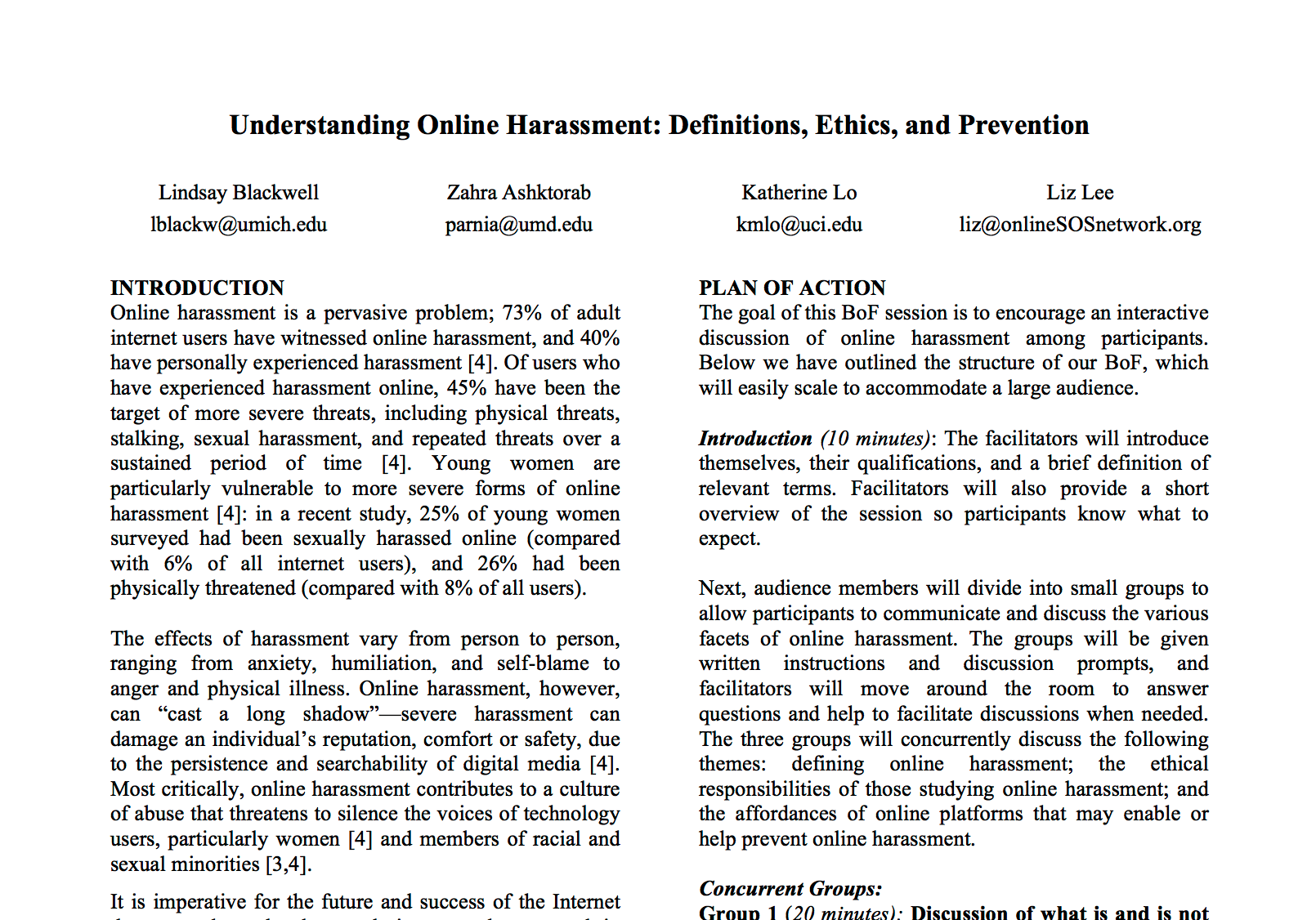
This BoF session was presented at Grace Hopper Celebration Women in Computing. The goal was to encourage an interactive discussion of online harassment among participants.
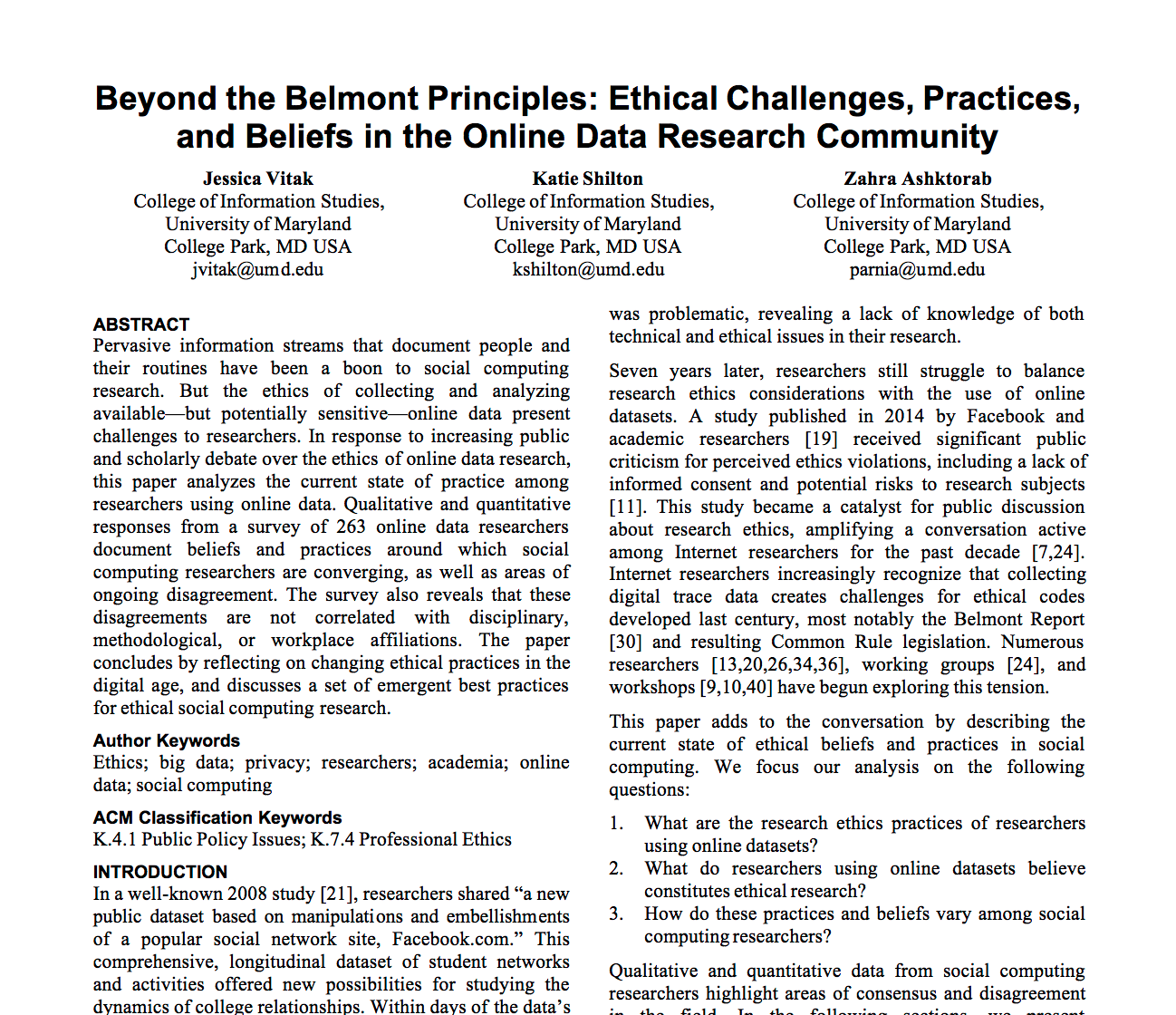
Pervasive information streams that document people and their routines have been a boon to social computing research. But the ethics of collecting and analyzing availableÑbut potentially sensitiveÑonline data present challenges to researchers. In response to increasing public and scholarly debate over the ethics of online data research, this paper analyzes the current state of practice among researchers using online data. Qualitative and quantitative responses from a survey of 263 online data researchers document beliefs and practices around which social computing researchers are converging, as well as areas of ongoing disagreement. The survey also reveals that these disagreements are not correlated with disciplinary, methodological, or workplace affiliations. The paper concludes by reflecting on changing ethical practices in the digital age, and discusses a set of emergent best practices for ethical social computing research.
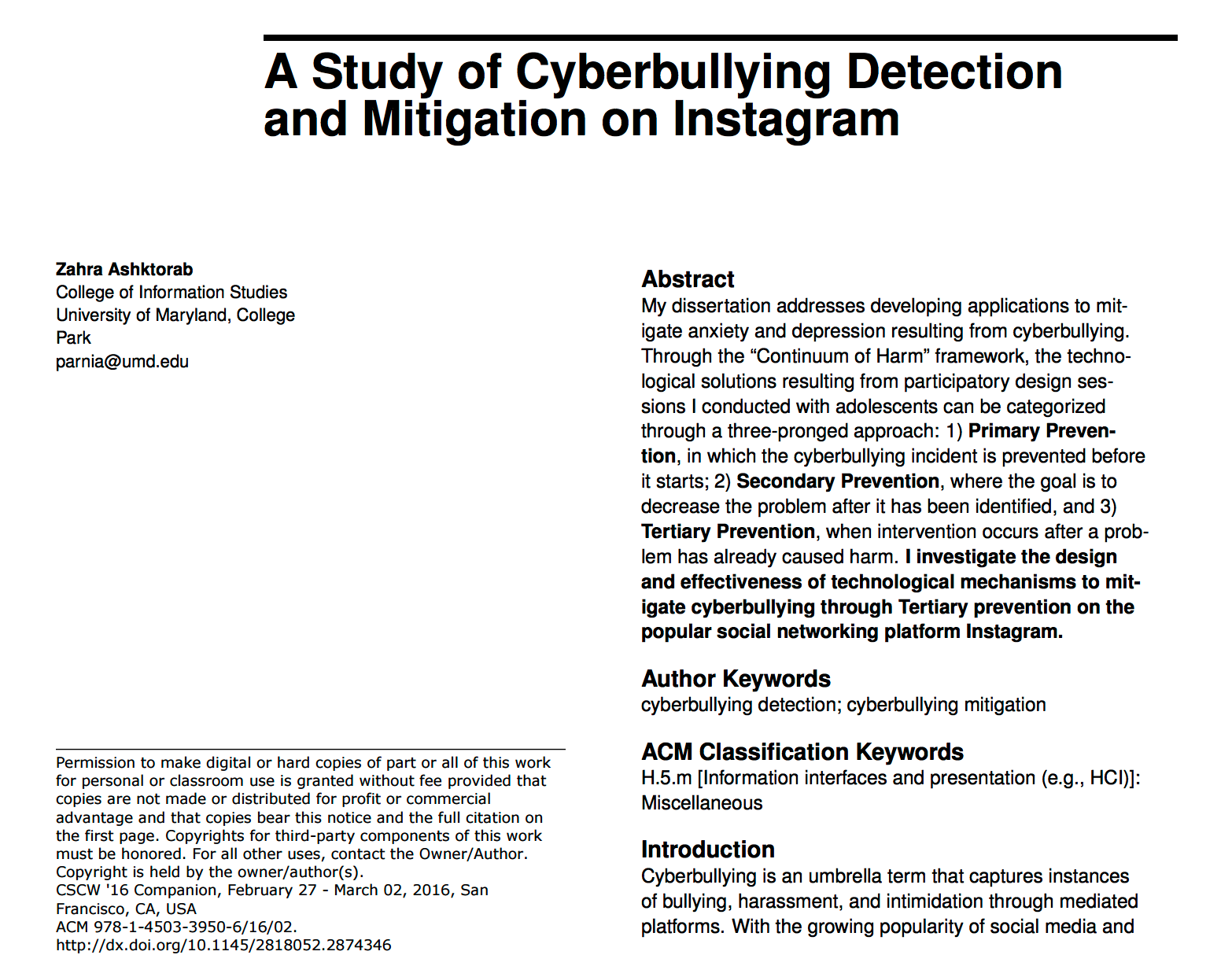
My dissertation addresses developing applications to mit-igate anxiety and depression resulting from cyberbullying. Through the “Continuum of Harm” framework, the technological solutions resulting from participatory design sessions I conducted with adolescents can be categorized through a three-pronged approach: 1) Primary Preven-tion, in which the cyberbullying incident is prevented before it starts; 2) Secondary Prevention, where the goal is to decrease the problem after it has been identified, and 3) Tertiary Prevention, when intervention occurs after a prob-lem has already caused harm. I investigate the design and effectiveness of technological mechanisms to mit-igate cyberbullying through Tertiary prevention on the popular social networking platform Instagram.
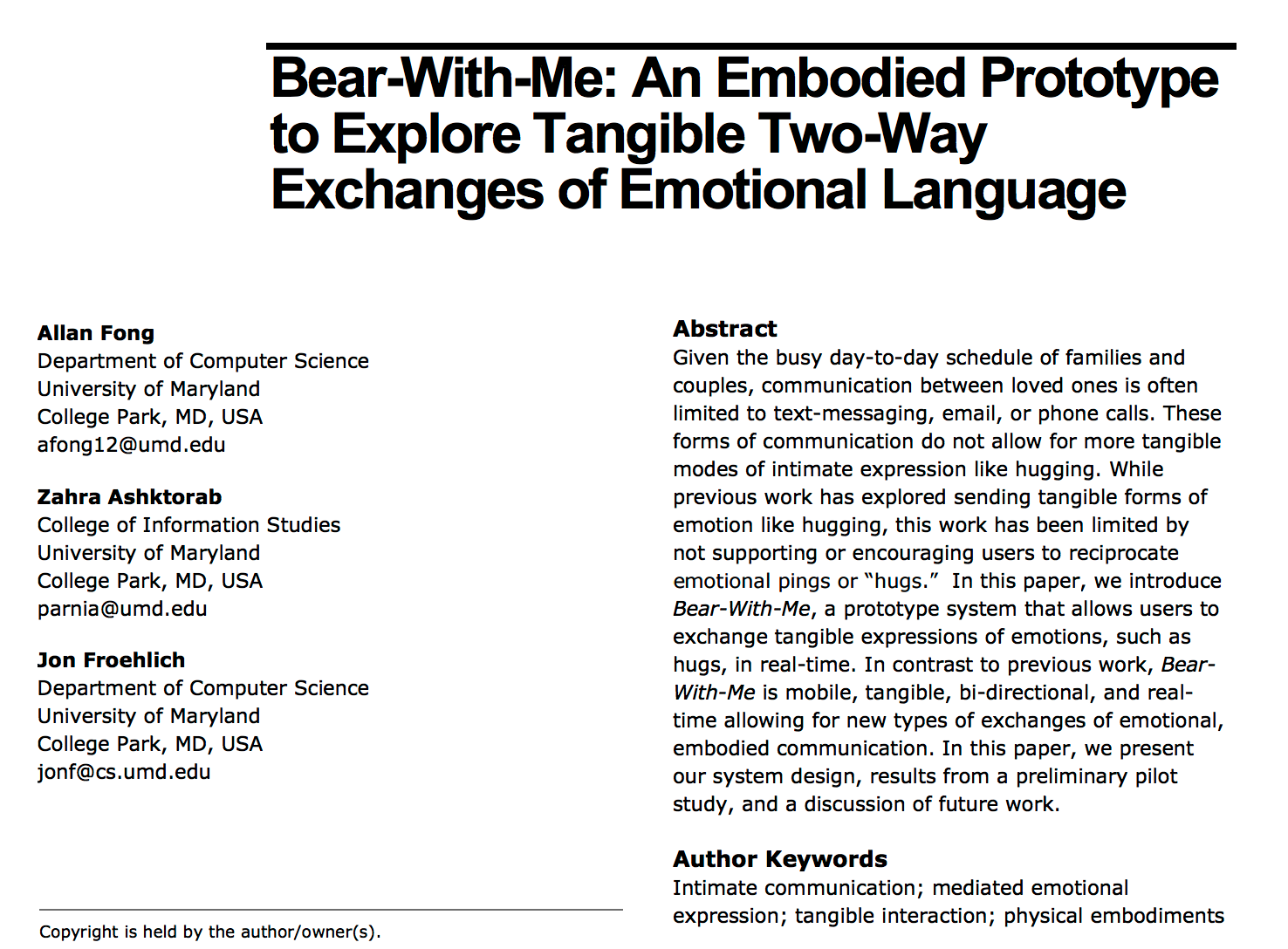
Given the busy day-to-day schedule of families and couples, communication between loved ones is often limited to text-messaging, email, or phone calls. These forms of communication do not allow for more tangible modes of intimate expression like hugging. While previous work has explored sending tangible forms of emotion like hugging, this work has been limited by not supporting or encouraging users to reciprocate emotional pings or “hugs.” In this paper, we introduce Bear-With-Me, a prototype system that allows users to exchange tangible expressions of emotions, such as hugs, in real-time. In contrast to previous work, BearWithMe is mobile, tangible, bi-directional, and realtime allowing for new types of exchanges of emotional, embodied communication. In this paper, we present our system design, results from a preliminary pilot study, and a discussion of future work.
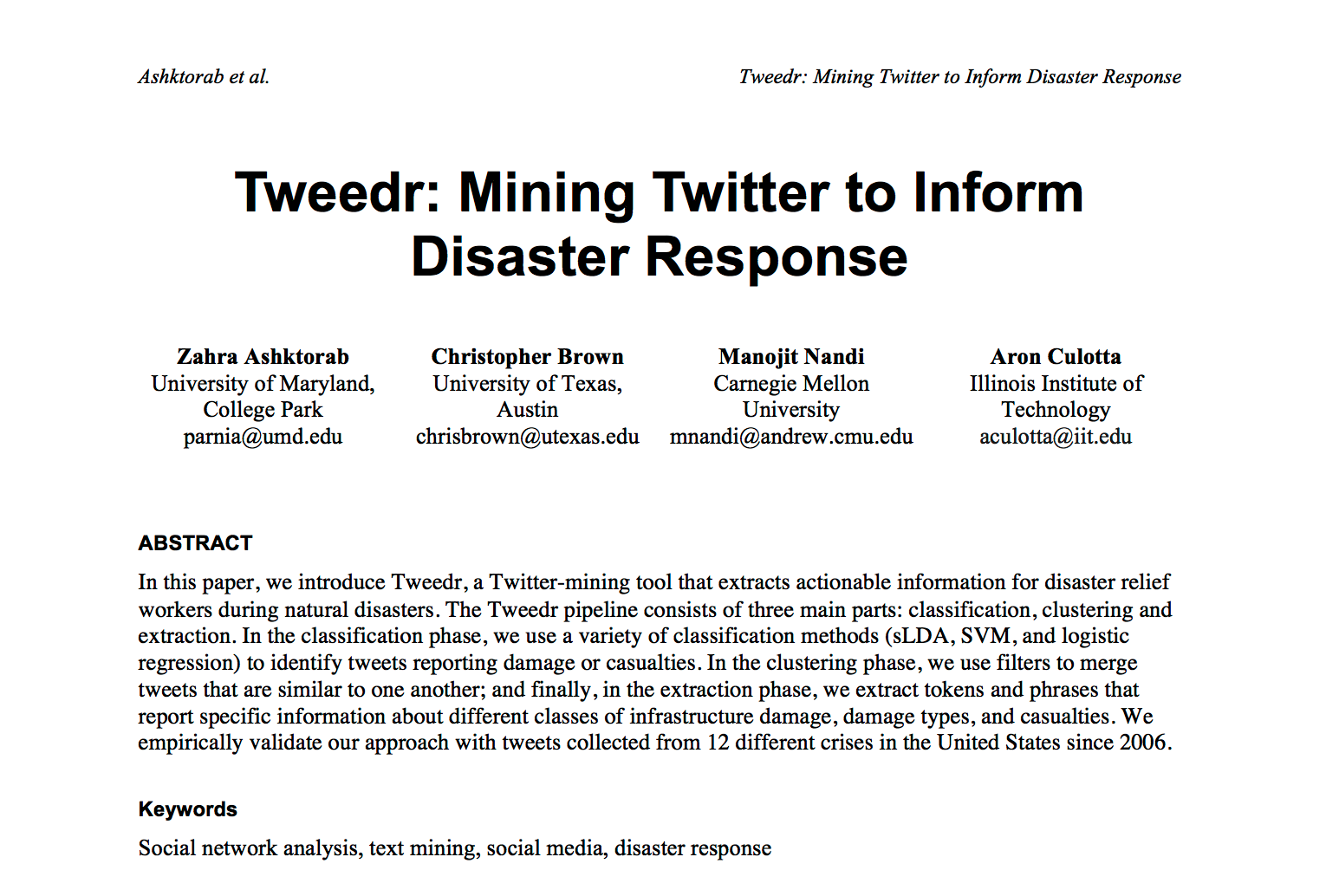
In this paper, we introduce Tweedr, a Twitter-mining tool that extracts actionable information for disaster relief workers during natural disasters. The Tweedr pipeline consists of three main parts: classification, clustering and extraction. In the classification phase, we use a variety of classification methods (sLDA, SVM, and logistic regression) to identify tweets reporting damage or casualties. In the clustering phase, we use filters to merge tweets that are similar to one another; and finally, in the extraction phase, we extract tokens and phrases that report specific information about different classes of infrastructure damage, damage types, and casualties. We empirically validate our approach with tweets collected from 12 different crises in the United States since 2006.
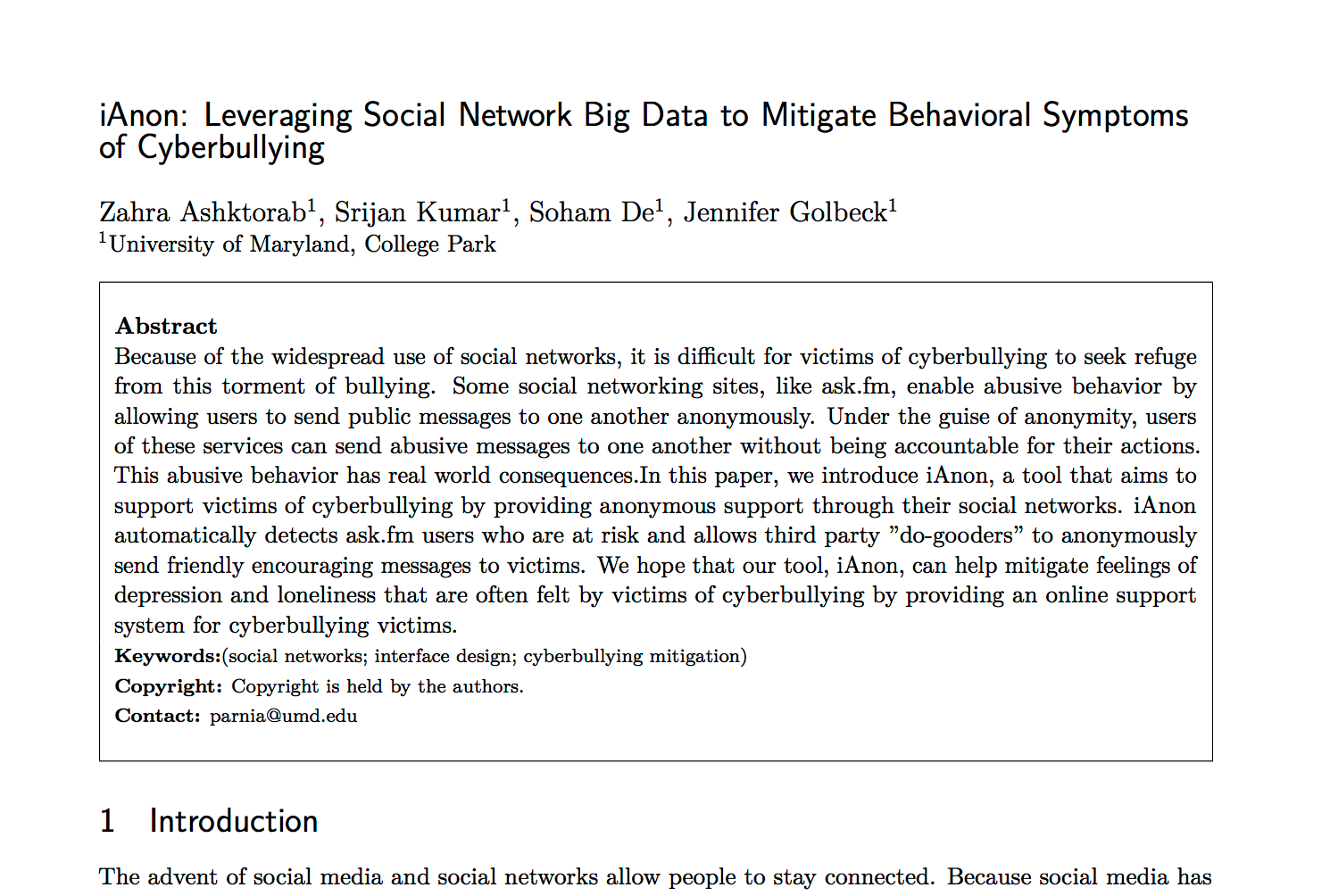
Because of the widespread use of social networks, it is difficult for victims of cyberbullying to seek refuge from this torment of bullying. Some social networking sites, like ask.fm, enable abusive behavior by allowing users to send public messages to one another anonymously. Under the guise of anonymity, users of these services can send abusive messages to one another without being accountable for their actions. This abusive behavior has real world consequences.In this paper, we introduce iAnon, a tool that aims to support victims of cyberbullying by providing anonymous support through their social networks. iAnon automatically detects ask.fm users who are at risk and allows third party ”do-gooders” to anonymously send friendly encouraging messages to victims. We hope that our tool, iAnon, can help mitigate feelings of depression and loneliness that are often felt by victims of cyberbullying by providing an online support system for cyberbullying victims.
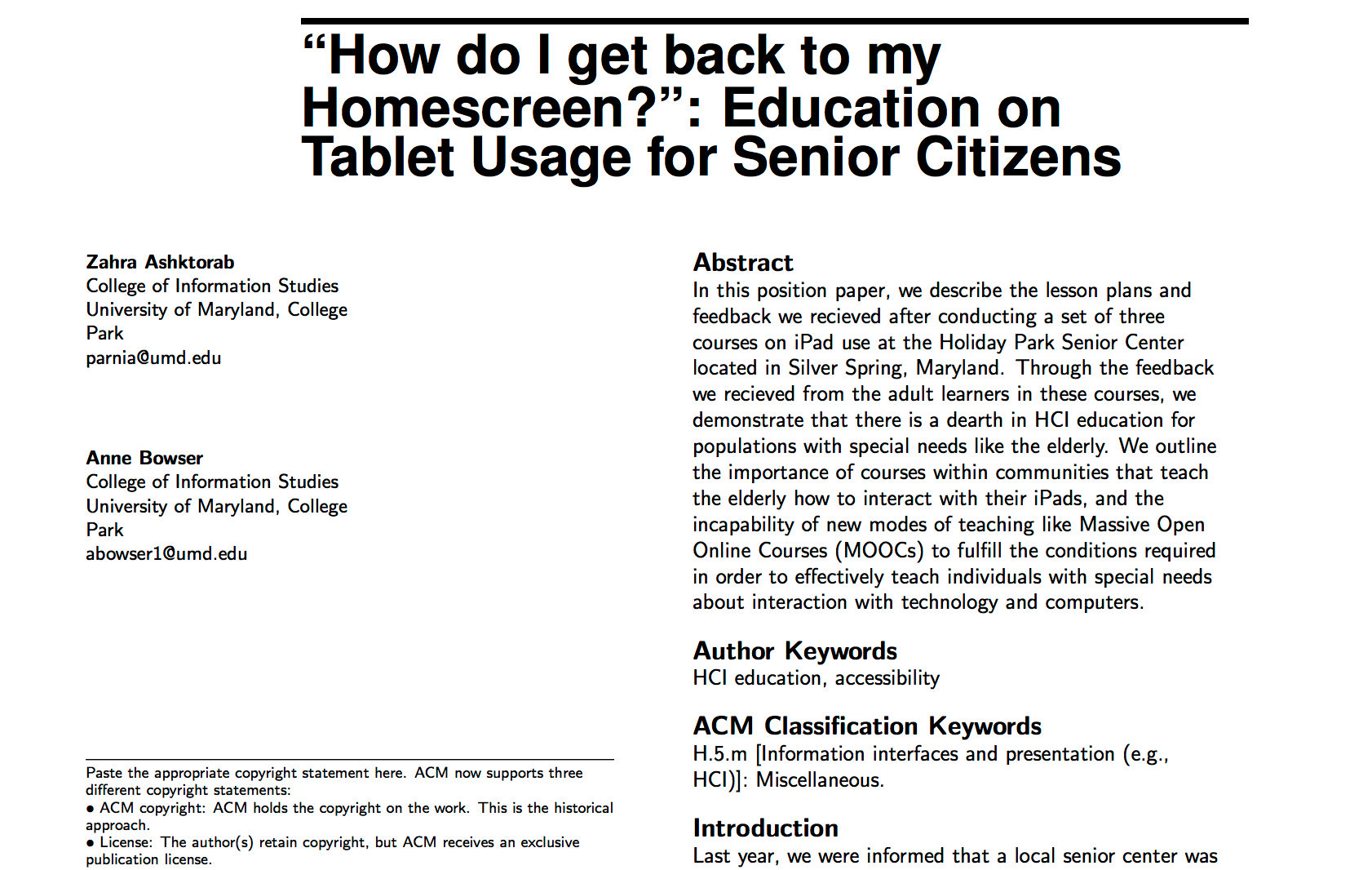
In this position paper, we describe the lesson plans and feedback we recieved after conducting a set of three courses on iPad use at the Holiday Park Senior Center located in Silver Spring, Maryland. Through the feedback we recieved from the adult learners in these courses, we demonstrate that there is a dearth in HCI education for populations with special needs like the elderly. We outline the importance of courses within communities that teach the elderly how to interact with their iPads, and the incapability of new modes of teaching like Massive Open Online Courses (MOOCs) to fulfill the conditions required in order to effectively teach individuals with special needs about interaction with technology and computers.
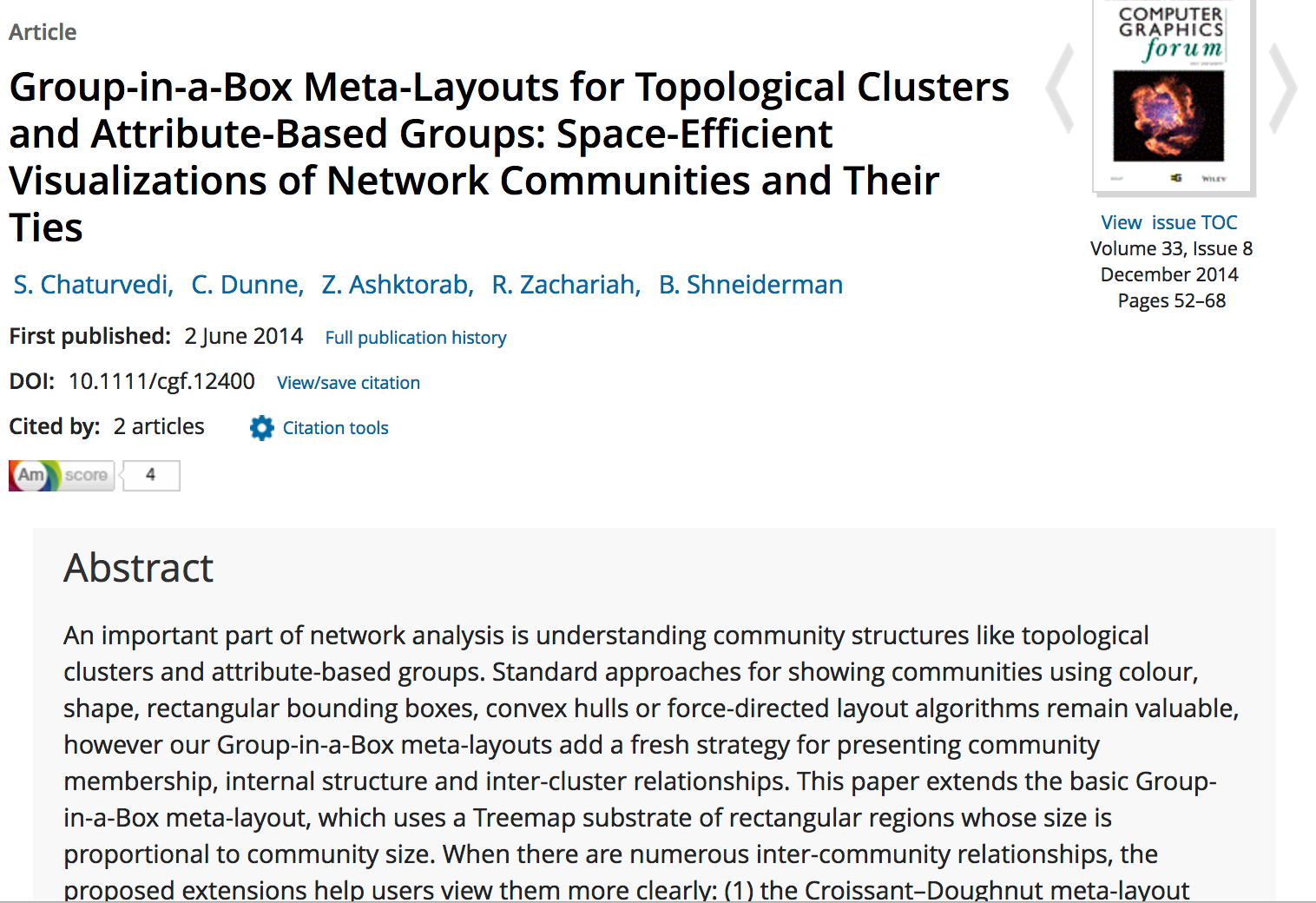
An important part of network analysis is understanding community structures like topological clusters and attribute-based groups. Standard approaches for showing communities using colour, shape, rectangular bounding boxes, convex hulls or force-directed layout algorithms remain valuable, however our Group-in-a-Box meta-layouts add a fresh strategy for presenting community membership, internal structure and inter-cluster relationships. This paper extends the basic Group-in-a-Box meta-layout, which uses a Treemap substrate of rectangular regions whose size is proportional to community size. When there are numerous inter-community relationships, the proposed extensions help users view them more clearly: (1) the Croissant–Doughnut meta-layout applies empirically determined rules for box arrangement to improve space utilization while still showing inter-community relationships, and (2) the Force-Directed layout arranges community boxes based on their aggregate ties at the cost of additional space. Our free and open source reference implementation in NodeXL includes heuristics to choose what we have found to be the preferable Group-in-a-Box meta-layout to show networks with varying numbers or sizes of communities. Case study examples, a pilot comparative user preference study (nine participants), and a readability measure-based evaluation of 309 Twitter networks demonstrate the utility of the proposed meta-layouts.